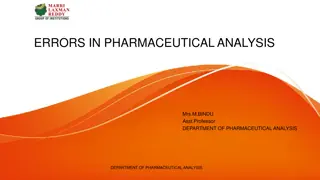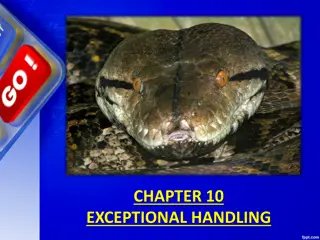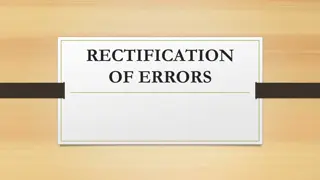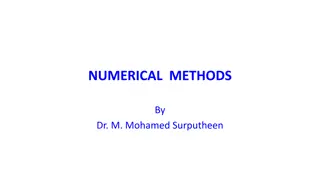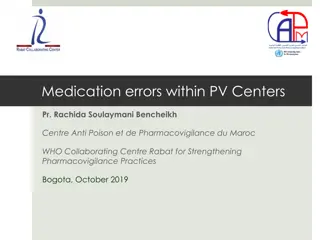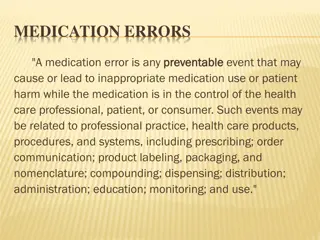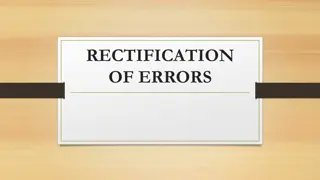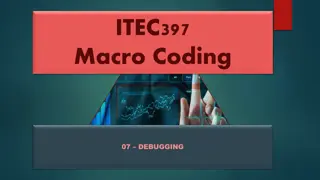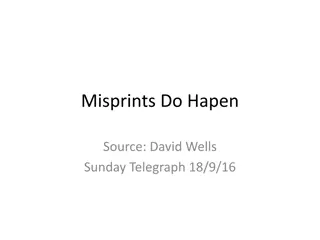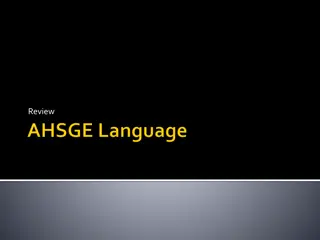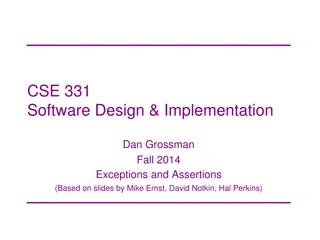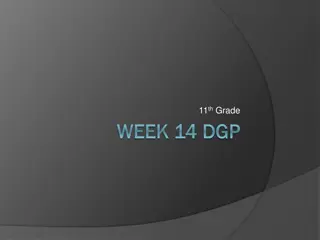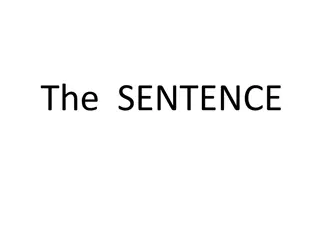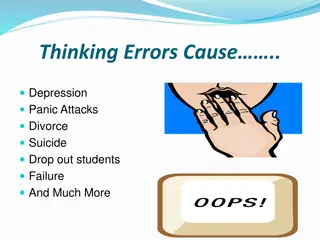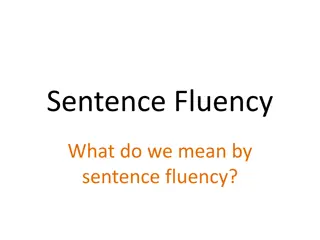Understanding and Avoiding Sentence Errors
Learn about the four basic types of sentence errors - sentence fragments, fused sentences, comma splices, and comma error problems. Understand the difference between phrases and clauses, and how to avoid sentence fragments by combining phrases or dependent clauses with independent clauses. Discover common pitfalls, such as misinterpreting fragments while proofreading, and the importance of proper punctuation to avoid fused sentences and comma splices.
Download Presentation

Please find below an Image/Link to download the presentation.
The content on the website is provided AS IS for your information and personal use only. It may not be sold, licensed, or shared on other websites without obtaining consent from the author. Download presentation by click this link. If you encounter any issues during the download, it is possible that the publisher has removed the file from their server.
E N D
Presentation Transcript
Workshop #4: Sentence Errors There are four basic types of sentence errors: 1. Sentence Fragments 2. Fused Sentences 3. Comma Splices 4. Comma Error problems
In order to understand and avoid sentence errors, one must revisit briefly Phrases and Clauses. Remember, a Phrase is a group of words that is missing a subject or a verb (or both). A Clause is what you get when you have at least a subject and a verb. They come in two types: 1. Independent has a subject, a verb, and a complete thought. 2. Dependent has a subject, a verb, but no complete thought.
If you have a Phrase or a Dependent Clause, it needs to be attached to an Independent Clause to make it work properly. Billy threw the ball through the glass window. He will have to pay for itbecause it shattered the glass. When he gets paid, Billy will write a check for the repairs. As a result, he will have no spare money.
If you have a Phrase or a Dependent Clause by itself, it is only a part of a sentence. It is a SENTENCE FRAGMENT. BAD EXAMPLES OF FRAGMENTS: Billy threw the ball. Through the glass window. He will have to pay for it.Because it shattered the glass. Billy will write a check for the repairs. When he gets paid. As a result.He will have no spare money. Notice that periods are crucial to this process. When you put down a period, you end a thought. You cannot just tack on more information after it like you might do when you are talking. Remember, talking is not the same as writing. People often speak using fragments in everyday conversation, so using fragments might SOUND normal, but it does not READ normal to your reader. Instead, it just reads as incomplete and choppy.
PITFALL with fragments: When you write, you know what you meant to write. Because of this fact, your brain may autocorrect as you proofread your own writing, and it may read a sentence as correct when it is not. However, your reader does not or may not know what you meant to say, and his or her brain will not autocorrect as he or she reads. The reader will read the incomplete and choppy fragment and feel confused. Hence, when proofreading and editing, slow down and pay attention to the PERIODS.
The next type of error is a FUSEDSENTENCE. A fused sentence happens when you jam two independent clauses together with no punctuation or coordination. Billy went to the zoo he saw the tigers. Billy went to the zoo he saw the tigers. These two independent clauses have been welded together with no flexibility or time for the reader to digest the two separate complete thoughts. As a result, it is too much too fast for the reader. To fix this problem, you have to learn to spot your clauses. Simply putting a comma there does not work. It just replaces one error with another error the COMMA SPLICE. FUSED Billy went to the zoo, he saw the tigers. Billy went to the zoo, he saw the tigers. You make this error because you feel tempted to put a comma wherever you take a breath or when you feel there should be a pause. However, that is not a rule, and you are making a writing like you talk mistake. Both of these mistakes are easily fixed with one of a few rules. Remember SPLICE
The last sentence error is a traditional standard run-on due to comma error. You may be tempted simply to add a FANBOYS (coordinating conjunction) to join the independent clauses. However, you cannot do that without putting a comma before the FANBOYS. Billy went to the zoo he saw the tigers. Billy went to the zoo and he saw the tigers. But this trick does not work because it is a comma error that makes a run-on. Again, you are just replacing an error with an error. How do you begin to fix all these errors? There are a few ways First, remember your coordinating conjunctions FANBOYS: For And Nor But Or Yet So They help you remember how to put independent clauses together, but you will need a comma too.
You can make independent clauses each its own sentence. Billy went to the zoo. He saw the tigers. You can use a semicolon to join two independent clauses. However, the clauses must be closely related or strongly contrasted. Billy went to the zoo; he hates that place. NOT: Billy went to the zoo; cheeseburgers are yummy. BAD (unrelated) You can turn one of the clauses into a dependent clause. Billy saw the tigers when he went to the zoo. OR When Billy went to the zoo, he saw the tigers. (Be sure to follow proper comma rules when you do this.) Or you can join the independent clauses using a comma followed by a FANBOYS (coordinating conjunction). Billy went to the zoo, and he saw the tigers. Billy does not like snakes, so he avoided the reptile house. Billy neither likes spiders, nor does he like scorpions. Billy slipped by the seal exhibit, for the ground was wet there. He hit the ground hard, but he was not hurt. He had a coupon for his ticket, yet he still had to pay full price.
Lets play NAME THAT ERROR! Look at the sentence in the examples. Then, name the type of error you see. Be careful, however, because a few will not have an error. If there is no error, then say correct. Knowing when there is no problem is just as important as knowing when there is one. Ready? Let s Begin!
Motorcycles are enjoyable but they are also very dangerous. Comma error run-on . One can be hurt badly in an accident cars hit bikes a lot. Fused . Bikes and cars need to share the road, and both riders and drivers need to pay attention. Correct . Spiders are not always a bad thing, they eat other insects when they are outside. Comma Splice . The schoolbus stopped at the railroad tracks. Because a train was crossing. Fragment . When you get to the store. Be sure to buy some milk. Fragment . I do not like to wake up early and when I do, I usually need coffee. Comma error run on .remember to spot the clauses . Mr. Johnson gives out the best Halloween candy lets trick-or-treat there first. Fused
Okay, for the next few sentences, describe how you would fix the error. I do not like sweets. Because all of my teeth fell out. Fragment fix by removing the period and making all one sentence. . There is a hole in the bucket and we cannot get the water properly. Comma error run-on put a comma between bucket and we. . The highway exit is next so you should move over to the right lane Comma error run-on put a comma between next and should. . When Billy was six years old, he went to the zoo and fell down he hates that place now. Fused use a semicolon, or make both separate sentences, or make one dependent. . Marty like to eat ice cream, he hates cake. Splice add a FANBOYS (coordinating conjunction) after the comma. . When I grow up, I want to be Superman, I can do good deeds for people. Splice again! put a FANBOYS (coordinating conjunction) after Superman and the comma.
One way to practice these skills everyday is to scan your friends social media posts (Twitter, Facebook) for errors to see if you can spot any. Text messaging is a great place to practice as well. Any Questions?



